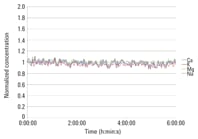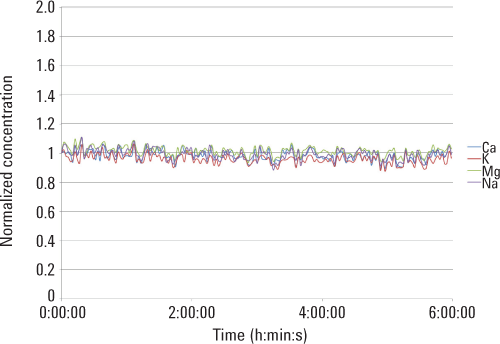Access Agilent eNewsletter, March 2014
>> Update My Profile | Subscribe to Access Agilent | Article Directory

Analysis of major elements in fruit juices using the Agilent 4200 MP-AES with the Agilent 4107 Nitrogen Generator
By Phuong Truong
Agilent R&D Chemist
and John Cauduro
Agilent Applications Chemist
Major elements such as calcium, magnesium, sodium, and potassium are essential nutrients in food, and the routine monitoring of these elements in fruit juices is a common quality control process. Flame atomic absorption spectroscopy (FAAS) is well-suited to this application because it delivers the required performance at a reasonable price. However, the introduction of the Agilent Microwave Plasma-Atomic Emission Spectrometer (MP-AES) has overcome several of the analytical challenges of FAAS for this application. The Agilent 4200 MP-AES is the ideal instrument for laboratories that want to transition away from FAAS to a more powerful and safer technique.
Numerous advantages over FAAS
The Agilent 4200 MP-AES main operating gas is nitrogen, which is supplied from an Agilent 4107 Nitrogen Generator (with air supplied from a compressor). This setup greatly reduces operating costs and eliminates the safety concerns associated with specialty gases required by FAAS, such as acetylene and nitrous oxide.
The nitrogen-based plasma source of the Agilent 4200 MP-AES operates at a higher temperature than the flame source of a FAAS, which avoids the chemical interferences present in FAAS (especially for elements such as Ca). This source eliminates the time-consuming, element-specific sample preparation and burner head changeover that is required when you analyze Ca, Na, K, and Mg in the same sample by FAAS.
The Agilent 4200 MP-AES also removes the need for costly and time-consuming modifiers and ionization suppressants. The plasma source in the 4200 MP-AES improves detection limits and linear dynamic range relative to FAAS. With no flammable gases required, the 4200 MP-AES is able to operate unattended, which increases sample throughput while allowing operators to focus on other tasks.
Fruit juice analysis shows value of MP-AES
We recently analyzed fruit juice samples using the Agilent 4200 MP-AES with an Agilent 4107 Nitrogen Generator. The sample introduction system consisted of a double-pass spray chamber and the Agilent OneNeb nebulizer.
The powerful and easy-to-use Agilent MP Expert software controlled the instrument. The 4200 MP-AES provides continuous wavelength coverage and MP Expert features an extensive wavelength database that allows you to select the wavelengths that are appropriate for the concentration range required for the analysis. For instance, in this application, we preferred the less sensitive Mg 518.360 nm line over the more sensitive Mg 285.213 line.
An Agilent Application Note (5991-3613EN) provides the full operating conditions for this analysis.
We analyzed two quality control (QC) test materials to validate the method:
- Apple Juice T1650QC certified by the Food and Environmental Research Agency, York, UK (FAPAS)
- Grapefruit Juice T0842QC certified by FAPAS
Additionally, we analyzed a commercially available apple juice for long-term stability studies.
We diluted all fruit juice samples 20-fold with 5% HNO3. No other modifiers or ionization suppressants were required. We prepared standards from a 10,000 mg/L multi-element standard (Inorganic Ventures). We prepared all calibration blanks and standards in 5% HNO3.
Results demonstrate excellent working range, recoveries, and long-term stability
The working concentration ranges of the standard solutions are summarized in Table 1. Because the working range of MP-AES far exceeds that of FAAS (by up to 20 times in some instances), we needed only one dilution of the sample to measure the complete set of elements.
Element |
Wavelength (nm) |
4200 MP-AES concentration range (mg/L) |
Correlation coefficient |
|---|---|---|---|
Calcium |
422.673 |
0–20 |
0.99990 |
Magnesium |
518.360 |
0–100 |
0.99988 |
Sodium |
589.592 |
0–20 |
0.99996 |
Potassium |
769.897 |
0–100 |
0.99968 |
Table 1. Working concentration range of the 4200 MP-AES standard solutions.
Table 2 shows the concentration and recovery results of the four elements in the two fruit juices. The recovery results for Ca, Mg, Na, and K in the fruit juices using this method were within +/- 10% of the assigned values. All results measured in this study were within the certified ranges of the two quality control test materials.
Apple Juice T0840QC |
Certified value (mg/L) |
Found (mg/L) |
% Recovery |
|
|---|---|---|---|---|
|
Assigned value |
Range |
|
|
Magnesium |
49.0 |
40.3–57.8 |
49.9 ± 0.6 |
102 |
Sodium |
21.2 |
16.9–25.4 |
22.2 ± 0.5 |
105 |
Potassium |
1044 |
926–1161 |
1039 ± 29.7 |
100 |
Grapefruit Juice T0842QC |
Certified value (mg/L) |
Found (mg/L) |
% Recovery |
|
|---|---|---|---|---|
|
Assigned value |
Range |
|
|
Calcium |
145.6 |
123.6–167.6 |
158.3 ± 3.2 |
109 |
Magnesium |
92.5 |
77.5–107.4 |
91.1 ± 0.6 |
99 |
Potassium |
1102 |
979–1225 |
1100 ± 14.7 |
100 |
Table 2. Excellent recovery results of four elements in the fruit juices using the Agilent 4200 MP-AES with the nitrogen generator.
 Enlarge
Enlarge
Figure 1. Stable results: normalized concentration of potassium in an apple juice sample over six hours.
To assess long-term stability, we diluted a commercial apple juice solution 20-fold with 5% HNO3 and repeatedly analyzed it over a period of six hours. Figure 1 shows the resulting stability plot. All elements have relative standard deviation (RSD) values of less than 4% over six hours. With the Agilent OneNeb nebulizer, we obtained excellent stability results for a sample with a complex high-sugar matrix.
Simple, rapid method with excellent results
A fast and easy method uses MP-AES to analyze Ca, Mg, Na, and K in fruit juice. The recoveries obtained from the analysis of the two QC test materials were within +/- 10% of the assigned values and within the certified concentration range. Using the standard sample introduction system supplied with the Agilent 4200 MP-AES, we obtained excellent long-term stability over a six-hour period.
The 4200 MP-AES is the ideal instrument if you need to transition away from FAAS and extend your laboratory’s analytical capabilities. Recognized benefits of MP-AES include reduced operating costs, enhanced productivity through numerous ease-of-use features and simplified sample preparation, improved safety, better detection limits, and greater linear dynamic range.
For more information about this analysis and a calculation of potential cost-savings when you transition from FAAS to the Agilent 4200 MP-AES, see Agilent publication number 5991-3613EN.
>> Update My Profile | Subscribe to Access Agilent | Article Directory
